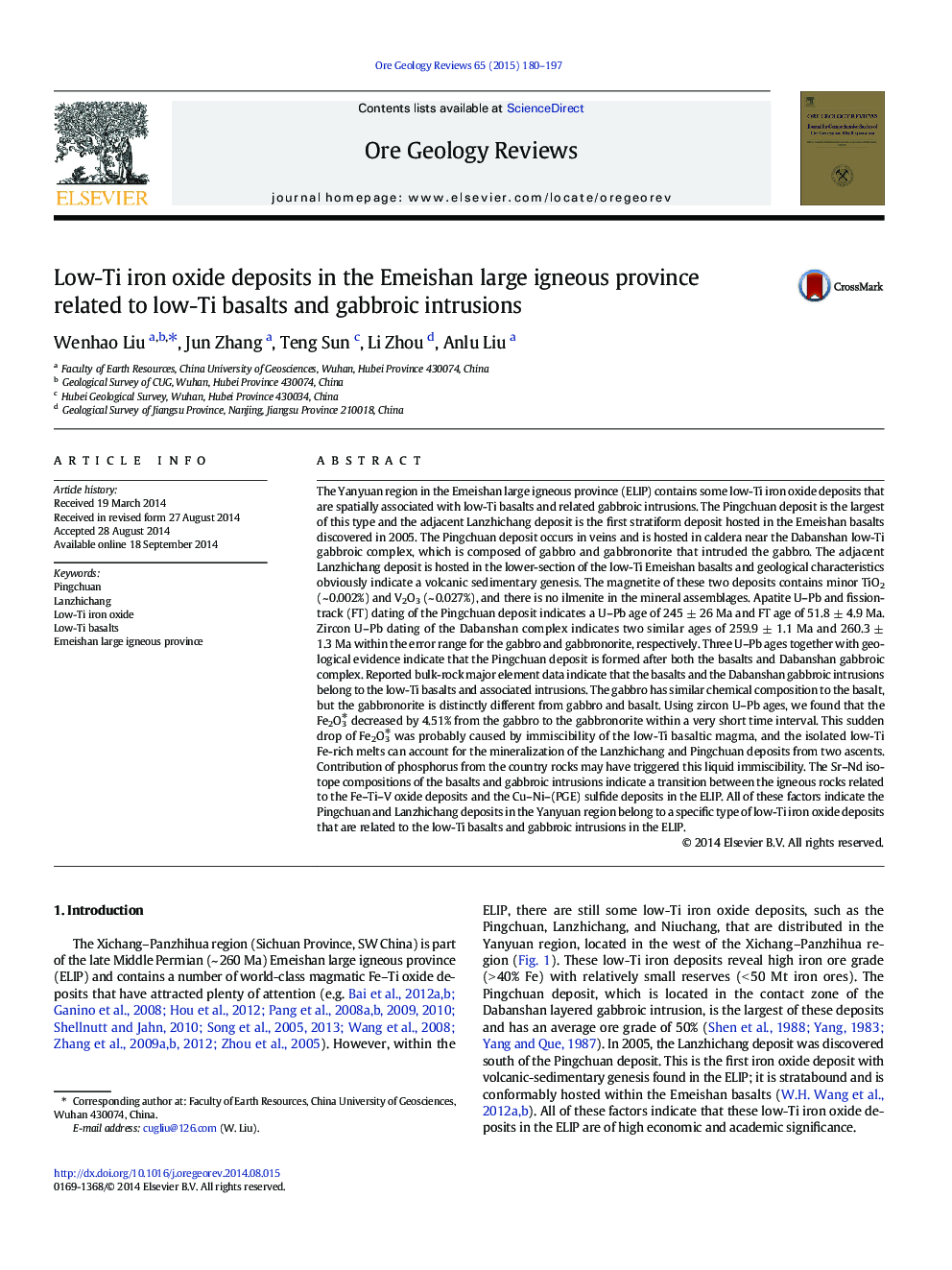| کد مقاله | کد نشریه | سال انتشار | مقاله انگلیسی | نسخه تمام متن |
|---|---|---|---|---|
| 4697254 | 1351868 | 2015 | 18 صفحه PDF | دانلود رایگان |

• Two low-Ti iron oxide deposits were identified in the ELIP.
• The magnetite contains minor TiO2 (~ 0.002%) and V2O3 (~ 0.027%).
• Low-Ti iron deposits were related to the low-Ti basalts and gabbroic intrusions.
• Liquid immiscibility of basaltic magma may account for the mineralization.
The Yanyuan region in the Emeishan large igneous province (ELIP) contains some low-Ti iron oxide deposits that are spatially associated with low-Ti basalts and related gabbroic intrusions. The Pingchuan deposit is the largest of this type and the adjacent Lanzhichang deposit is the first stratiform deposit hosted in the Emeishan basalts discovered in 2005. The Pingchuan deposit occurs in veins and is hosted in caldera near the Dabanshan low-Ti gabbroic complex, which is composed of gabbro and gabbronorite that intruded the gabbro. The adjacent Lanzhichang deposit is hosted in the lower-section of the low-Ti Emeishan basalts and geological characteristics obviously indicate a volcanic sedimentary genesis. The magnetite of these two deposits contains minor TiO2 (~ 0.002%) and V2O3 (~ 0.027%), and there is no ilmenite in the mineral assemblages. Apatite U–Pb and fission-track (FT) dating of the Pingchuan deposit indicates a U–Pb age of 245 ± 26 Ma and FT age of 51.8 ± 4.9 Ma. Zircon U–Pb dating of the Dabanshan complex indicates two similar ages of 259.9 ± 1.1 Ma and 260.3 ± 1.3 Ma within the error range for the gabbro and gabbronorite, respectively. Three U–Pb ages together with geological evidence indicate that the Pingchuan deposit is formed after both the basalts and Dabanshan gabbroic complex. Reported bulk-rock major element data indicate that the basalts and the Dabanshan gabbroic intrusions belong to the low-Ti basalts and associated intrusions. The gabbro has similar chemical composition to the basalt, but the gabbronorite is distinctly different from gabbro and basalt. Using zircon U–Pb ages, we found that the Fe2O3⁎ decreased by 4.51% from the gabbro to the gabbronorite within a very short time interval. This sudden drop of Fe2O3⁎ was probably caused by immiscibility of the low-Ti basaltic magma, and the isolated low-Ti Fe-rich melts can account for the mineralization of the Lanzhichang and Pingchuan deposits from two ascents. Contribution of phosphorus from the country rocks may have triggered this liquid immiscibility. The Sr–Nd isotope compositions of the basalts and gabbroic intrusions indicate a transition between the igneous rocks related to the Fe–Ti–V oxide deposits and the Cu–Ni–(PGE) sulfide deposits in the ELIP. All of these factors indicate the Pingchuan and Lanzhichang deposits in the Yanyuan region belong to a specific type of low-Ti iron oxide deposits that are related to the low-Ti basalts and gabbroic intrusions in the ELIP.
Journal: Ore Geology Reviews - Volume 65, Part 1, March 2015, Pages 180–197